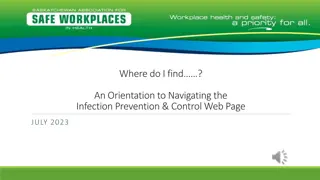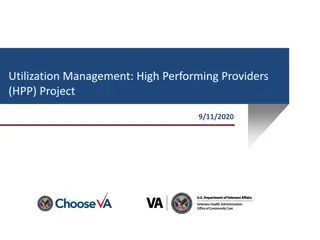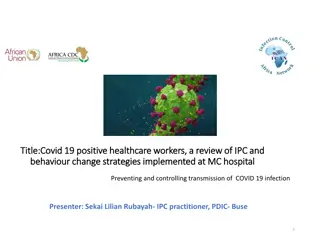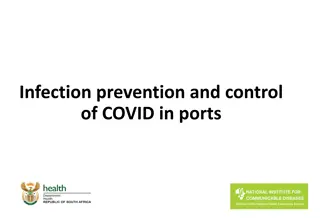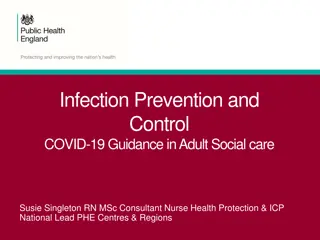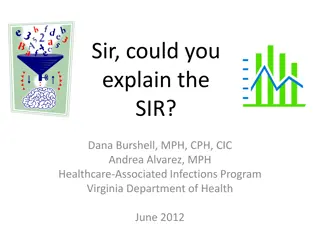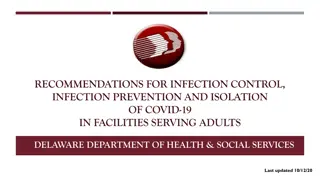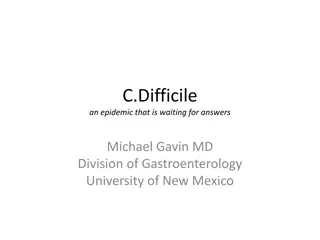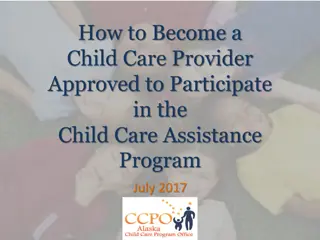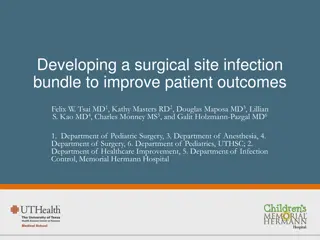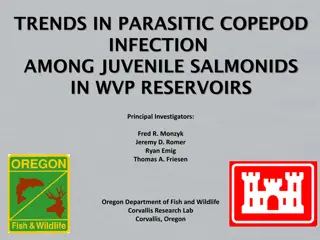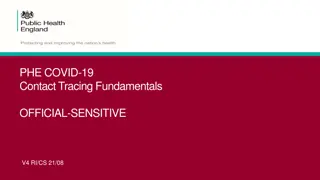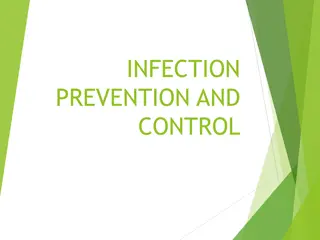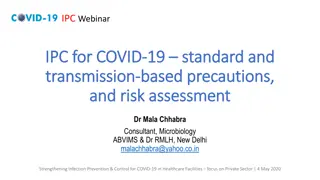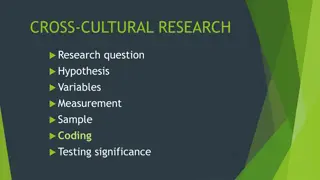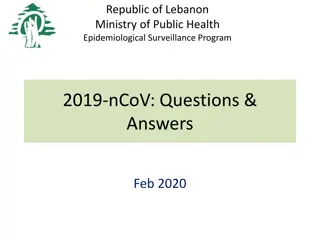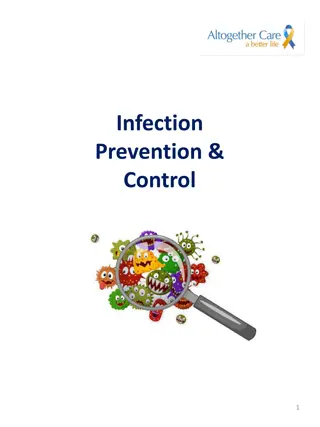COVID-19 Infection Control Measures for Community Providers
COVID-19, caused by SARS-CoV-2, is a viral disease that spreads through respiratory droplets. Common symptoms include fever, cough, and loss of taste or smell. Prevention measures include hand hygiene, PPE use, social distancing, and symptom screening. Staff should practice hand hygiene, cough etiquette, and maintain physical distancing. Other measures include maintaining a 2-meter physical distance.
Download Presentation

Please find below an Image/Link to download the presentation.
The content on the website is provided AS IS for your information and personal use only. It may not be sold, licensed, or shared on other websites without obtaining consent from the author. Download presentation by click this link. If you encounter any issues during the download, it is possible that the publisher has removed the file from their server.
E N D
Presentation Transcript
Coronavirus (COVID-19) Infection Control Measures for Community Providers December 2020 Eleanor Burrell IPAC Team
COVID-19 SARS CoV-2 (COVID-19) is an infectious viral disease caused by a newly discovered coronavirus. COVID-19 has the potential to spread widely as lack of immunity means everyone in population is susceptible. The most common symptoms of COVID-19 are fever, dry cough and loss of/altered taste or smell. Other symptoms include aches and pains, headache, sore throat, nasal congestion, and diarrhoea. Elderly people may present with confusion, lethargy and decline in alertness/mobility. Symptoms start 1-14 days after exposure. COVID-19 is mainly transmitted through droplets generated when an infected person coughs or sneezes these droplets onto mouth, eyes or nose. Requires close contact (within 2 meters) Contact with respiratory secretions: - Hands - Contaminated surfaces, tissues - Transferred by touching nose, mouth, eyes with contaminated hands
Preventing the spread of COVID-19: Infection prevention and control measures to protect both residents and staff Robust track and trace system in care homes and client s houses to ensure all staff and visitors are accounted for Hand hygiene Personal Protective Equipment (PPE) Temperature checks (at the discretion of provider) Symptom checker can be completed through written or verbal questionnaire Social distancing - maintaining 2 metre distancing with good ventilation Participate in COVID-19 screening programme Cleaning Isolation of symptomatic residents
Staff Hand Hygiene Cough etiquette Advise staff not to come to work if they have any COVID-19 symptoms. They must call the helpline on 445566 to arrange COVID-19 testing and self isolate Encourage all staff including carers, housekeepers, catering staff and caretakers to participate in the workforce swabbing programme Staff must ensure physical distancing of 2 metres is maintained when on breaks as masks will be removed to eat and drink Staff should not car share, however if this is essential they must wear a surgical mask as physical distancing cannot be maintained and keep the vehicle well ventilated by opening windows Increase environmental cleaning within the property and ensure all touch points are cleaned frequently throughout the day Provision and strict adherence of PPE
Other measures Maintain physical distancing of 2 metres of residents when in communal areas including the dining room Clean all equipment and hard surfaces with disinfectant wipes after each use Stagger staff breaks to ensure limited numbers on break at the same time Isolation of symptomatic residents
Personal Protective Equipment (PPE) PPE will only prevent the spread of infection if it is used and changed at the right time, accompanied by good hand hygiene and cough etiquette is applied. All staff including housekeeping staff must be trained in how to use PPE. Follow local guidelines: All staff must wear a surgical face mask on arrival to work and wear for sessional use i.e. when on break, take a new one and dispose of used mask. Change masks if you have a break or if the mask becomes moist or visibly dirty. For direct client contact you must wear disposable gloves and disposable apron. You may also need a visor (risk assess for droplet/body fluid exposure). FFP3 masks and gowns are required for aerosol generating procedures (AGPs). You must pass a fit mask test to wear an FFP3 mask. Gloves and aprons must be removed and discarded after each episode of care/task. Always decontaminate hands after each task performed. Please decontaminate hands on removal of all PPE
Personal Protective Equipment (PPE) Surgical face mask Disposable apron Disposable gloves Visor To be worn by all staff at all times To be worn for direct contact To be worn for direct contact To be worn for droplet exposure
Putting on PPE SEQUENCE FOR PUTTING ON PERSONAL PROTECTIVE EQUIPMENT (PPE) Before donning PPE, healthcare workers should put on scrubs, ensure hair is tied back securely and off the neck and collar, remove jewellery/pens, ensure they are hydrated, and perform hand hygiene. The order given below is practical but the order for putting on is less critical than the order of removal. Gowns and FFP3 masks are only required for aerosol generating procedures (list of AGP s on Gov.je) During donning each item must be adjusted as required to ensure it fits correctly and interfaces well with other PPE items. FFP3 masks should be worn.
Taking off PPE SEQUENCE FOR TAKING OFF PERSONAL PROTECTIVE EQUIPMENT (PPE) PPE should be removed in an order that minimises the potential for cross-contamination. Before leaving the ante-room gloves, gown, eye protection and respirator should be removed (in that order, where worn) and disposed of as hazardous waste. 1.Peel off gloves 2.Perform hand hygiene 3. Remove gown by using a peeling motion, fold gown in on itself and place in hazardous waste 4. Remove goggles/visor only by the headband or sides and dispose in hazardous waste 5. Remove respirator from behind and dispose in hazardous waste 6.Perform hand hygiene
Suspected case of COVID-19 Isolate those with symptoms (residents must stay in their room with own dedicated bathroom). Isolation includes meals in their room. Isolate residents who have been in close contact with symptomatic resident or confirmed positive case. Enhanced cleaning. Dedicate medical equipment for suspected case. Clean and disinfect equipment before use on another resident. Dedicated staffing where possible Test resident for COVID-19 Inform infection control Follow correct waste disposal guidelines. Available at: https://www.gov.je/Health/Coronavirus/HealthCareProfessionals/Pages/ GuidanceCareHomesDisposalWaste.aspx
Useful numbers and email addresses PPE@gov.je PPE portal to order masks, aprons, gloves, alcohol hand gel and wipes FITmasktesting@health.gov.je to arrange FIT mask testing if you are carrying out aerosol generating procedures on anyone E.burrell@health.gov.je or 44485/07797733451/ bleep 616 Infection Control Sister Eleanor Burrell COVID-19 helpline 445566 Contact Tracing team 449944



